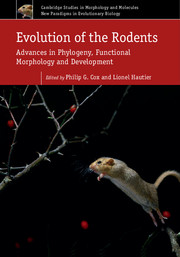Book contents
- Frontmatter
- Contents
- List of contributors
- Foreword
- 1 Rodentia: a model order?
- 2 A synopsis of rodent molecular phylogenetics, systematics and biogeography
- 3 Emerging perspectives on some Paleogene sciurognath rodents in Laurasia: the fossil record and its interpretation
- 4 Phylogeny and evolutionary history of hystricognathous rodents from the Old World during the Tertiary: new insights into the emergence of modern “phiomorph” families
- 5 The history of South American octodontoid rodents and its contribution to evolutionary generalisations
- 6 History, taxonomy and palaeobiology of giant fossil rodents (Hystricognathi, Dinomyidae)
- 7 Advances in integrative taxonomy and evolution of African murid rodents: how morphological trees hide the molecular forest
- 8 Themes and variation in sciurid evolution
- 9 Marmot evolution and global change in the past 10 million years
- 10 Grades and clades among rodents: the promise of geometric morphometrics
- 11 Biogeographic variations in wood mice: testing for the role of morphological variation as a line of least resistance to evolution
- 12 The oral apparatus of rodents: variations on the theme of a gnawing machine
- 13 The muscles of mastication in rodents and the function of the medial pterygoid
- 14 Functional morphology of rodent middle ears
- 15 Variations and anomalies in rodent teeth and their importance for testing computational models of development
- 16 The great variety of dental structures and dynamics in rodents: new insights into their ecological diversity
- 17 Convergent evolution of molar topography in Muroidea (Rodentia, Mammalia): connections between chewing movements and crown morphology
- 18 Developmental mechanisms in the evolution of phenotypic traits in rodent teeth
- 19 Diversity and evolution of femoral variation in Ctenohystrica
- 20 Morphological disparity of the postcranial skeleton in rodents and its implications for palaeobiological inferences: the case of the extinct Theridomyidae (Rodentia, Mammalia)
- Index
- References
17 - Convergent evolution of molar topography in Muroidea (Rodentia, Mammalia): connections between chewing movements and crown morphology
Published online by Cambridge University Press: 05 August 2015
- Frontmatter
- Contents
- List of contributors
- Foreword
- 1 Rodentia: a model order?
- 2 A synopsis of rodent molecular phylogenetics, systematics and biogeography
- 3 Emerging perspectives on some Paleogene sciurognath rodents in Laurasia: the fossil record and its interpretation
- 4 Phylogeny and evolutionary history of hystricognathous rodents from the Old World during the Tertiary: new insights into the emergence of modern “phiomorph” families
- 5 The history of South American octodontoid rodents and its contribution to evolutionary generalisations
- 6 History, taxonomy and palaeobiology of giant fossil rodents (Hystricognathi, Dinomyidae)
- 7 Advances in integrative taxonomy and evolution of African murid rodents: how morphological trees hide the molecular forest
- 8 Themes and variation in sciurid evolution
- 9 Marmot evolution and global change in the past 10 million years
- 10 Grades and clades among rodents: the promise of geometric morphometrics
- 11 Biogeographic variations in wood mice: testing for the role of morphological variation as a line of least resistance to evolution
- 12 The oral apparatus of rodents: variations on the theme of a gnawing machine
- 13 The muscles of mastication in rodents and the function of the medial pterygoid
- 14 Functional morphology of rodent middle ears
- 15 Variations and anomalies in rodent teeth and their importance for testing computational models of development
- 16 The great variety of dental structures and dynamics in rodents: new insights into their ecological diversity
- 17 Convergent evolution of molar topography in Muroidea (Rodentia, Mammalia): connections between chewing movements and crown morphology
- 18 Developmental mechanisms in the evolution of phenotypic traits in rodent teeth
- 19 Diversity and evolution of femoral variation in Ctenohystrica
- 20 Morphological disparity of the postcranial skeleton in rodents and its implications for palaeobiological inferences: the case of the extinct Theridomyidae (Rodentia, Mammalia)
- Index
- References
Summary
Introduction
Understanding mammalian tooth crown morphological changes during evolution constitutes a crucial area of investigation common to both palaeontology and developmental biology (Osborn, 1907; Hershkovitz, 1962; Hunter and Jernvall, 1994; Jernvall, 2000; Kangas et al., 2004; Kavanagh et al., 2007; Charles et al., 2009a,b; Harjunmaa et al., 2012). During the past two decades, relationships between tooth morphology, diet and mastication have been deciphered through topographic analyses of the crown surface (e.g. Reed, 1997; Jernvall and Selänne, 1999; Evans et al., 2007; Lazzari et al., 2008a,b; Boyer et al., 2010;Wilson et al., 2012). Such an approach allowed the investigation of several well-documented primate, rodent and multituberculate lineages showing drastic modifications of dental morphology.
Including about one third of modern mammalian biodiversity, present in all the main continental landmasses except Antarctica and New Zealand, the superfamily Muroidea (rats, mice, gerbils, hamsters, voles … sensu Musser and Carleton, 2005) displays a huge diversity of cheek teeth in terms of cusp arrangement and crown elevation, that can be associated with different masticatory modes and diets (Butler 1980, 1985; Lazzari et al., 2008b, 2011; Coillot et al., 2013). It has also a very rich fossil record, and a now well-established phylogeny concerning extant species (Jansa and Weksler, 2004; Steppan et al., 2004; Jansa et al., 2009; Fabre et al., 2012).
For these reasons, Muroidea are exceptional in providing many examples that can be used to study the modalities and mechanisms of molar crown diversification not only because the fossil record of many muroid subfamilies is well-documented but because there are many cases of parallel and convergent evolutions of dental morphologies. Such convergences involve the recurrent emergences of supplementary cusps, but also hypsodonty, lophodonty (formation of crests) or formation of prismatic crowns. These convergences alter the phylogenetic signal carried by the teeth and greatly complicate morphological cladistic studies (De Bruijn et al., 1996).
- Type
- Chapter
- Information
- Evolution of the RodentsAdvances in Phylogeny, Functional Morphology and Development, pp. 448 - 477Publisher: Cambridge University PressPrint publication year: 2015
References
- 6
- Cited by



